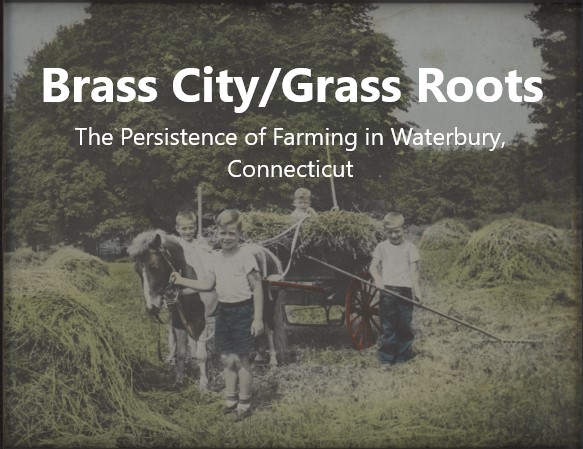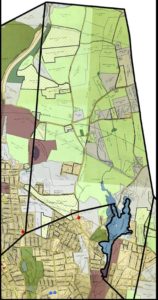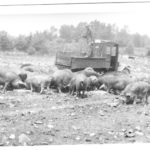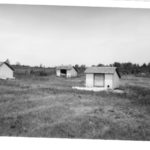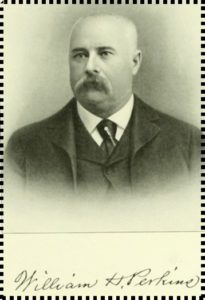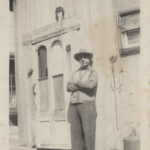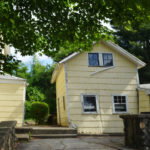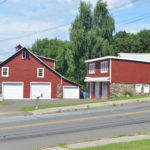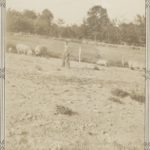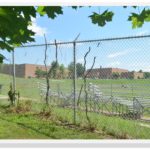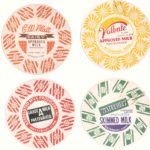This article is part of the digital exhibit Brass City/Grass Roots: The Persistence of Farming in Waterbury, Connecticut. Use the arrows at the bottom of the page to navigate to other parts of the exhibit.
Although Yankee settlers lived in Buck’s Hill since the early 1700s, in the late 19th century the area was still a thriving agricultural enclave virtually untouched by the industry spreading throughout much of Waterbury. Neighborhood residents belonged to the 4H Club and the Farm Bureau and held 4th of July picnics and other celebrations. Religious life was also contained in the community: the Faber family donated land on which residents built the Bucks Hill Union Chapel and then went down in a buggy to pick up a preacher to preside over services. Children attended a two-room schoolhouse until the middle of the 20th century. In fact, residents had to work hard just a few decades ago to get basic services such as water and sewers into the area. As Ann Dellorfano put it, “We went downtown to city hall all the time. That’s how we got sewers, that’s how we got our schools.” Ironically, the modernization that helped the neighborhood’s farm families also made the area more attractive for the development of suburban-style housing tracts, hastening the decline of the farms and diminishing the community’s rural feel.
Here are stories of some of the farms of the distant and recent past and present that have given the area its character.
My brother went to get manure, and him and his friend, two city boys, went down to Southbury, and the farmer asked them do you want the fresh or the dried manure. They thought they were buying bread! They wanted the fresh one, and they gagged all the way home, dumped it out, and me and my mother had to shovel and spread it. My father enjoyed being out there until he really couldn’t do it anymore, and my mother did, too. When we first moved here, it was in the fall, and the next spring she wanted to make a garden right away and he didn’t want to do it because he didn’t even have the property landscaped. So she walked down to Schmidt’s and Serafine’s [local hardware store], bought a pitchfork, and walked back up the hill with it on her shoulder and started digging.
—Anne Mary Summa
- Arthur Reichenbach (1893-1981) owned a pig and chicken farm with some 12.5 acres adjacent to the 3000-3100 block of North Main Street. Art fed his stock only “the best.” He had contracts with markets and restaurants downtown to collect their unused produce. These may have included the Hotel Elton, Drescher and Keck Café, Mohegan Market, Fulton Market, The Front Page Restaurant, etc. My theory is that he swapped fresh pork and eggs for the privilege of getting first choice of their garbage. Art was one of 10 children of Edelbert, a German immigrant, and Henrietta Reichenbach, a German American. The couple had built a grocery store and residence on upper Walnut St. before moving to a farm on Chestnut Hill Rd., now Farmwood Rd., near Lyman’s Pond. My mother was one of his sisters. His brother Howard Reichenbach, a designer for Chase Brass and Copper Co. is in the Waterbury Hall of Fame. Art was well liked by everyone he met. He was a famous spinner of “yarns” and had a great sense of humor. He had great respect for all–including his animal “family.” – Text and photos courtesy of Brenda Anderson-Killer and Ken Killer, click to enlarge
- The smaller buildings on the Reichenbach farm were birthing houses where sows were kept separately where they bore and suckled their pigs – Information and photos courtesy of Brenda Anderson-Killer and Ken Killer, click to enlarge
William H. Perkins was “an enterprising and progressive gentleman farmer of Buck’s Hill” who also owned property in Waterville. His father had been a carpenter and contractor who built a number of prominent Waterbury buildings. Perkins Sr. helped establish the city mill around 1850. It turned the first water wheel in Waterbury that was used specifically for manufacturing. William H. was also a carpenter, but “in 1887, he removed to what is now Perkins avenue, on Buck’s Hill, and turned his attention to the operation of the Holt farm, upon which he has made extensive improvements, including the erection of a fine residence, beautifully located, and supplied with all modern conveniences. He has built an artificial lake which is well stocked with fine fish, and on which he has a pleasure boat. He keeps about twenty head of cattle, to supply the family wants. Fancy dogs and game chickens are bred here with much success, and Mr. Perkins’ Great Dane ‘Grover’ is one of the best dogs in New England. Mr. Perkins is erecting, regardless of expense, extensive chicken barns, completely furnished with numerous incubators.”
—Commemorative Biographical Record of New Haven County (Chicago: J.H. Beers & Co., 1902)
- Giacomo “Charles” Dellorfano, from a family farming in Avellino, Italy, first worked on railroads in Pennsylvania before coming to Waterbury. He boarded with Anthony and Josephine DiStasio, recent immigrants who owned a meat store. Charles married their daughter, Anna, and by the 1920s had bought a farm of about 70 acres with his new parents-in-law. Laurel Hill Dairy Farm had two working horses and dairy cows, chickens, vegetables and “two pigs every year for the family.” Family members peddled milk, eggs, and cheese from a wagon and sold produce at the municipal farmers’ market. Although the farmland has since mostly been sold for house lots, Anthony Dellorfano, Charles and Anna’s son, still cultivates a large vegetable garden – Photo courtesy of Tony and Ann Dellorfano, click to enlarge
- The old milk house used by the Dellorfanos still stands—leaning a little—on Grassy Hill Road – Photo courtesy of Georgia Sheron, click to enlarge
William M. Tyler was “one of the most successful and progressive agriculturalists on Buck’s Hill…He devotes considerable attention to fruit growing and dairy farming.” Tyler was born in Middlebury in 1837, where his family had farmed for generations. He settled first in Bunker Hill in 1859, but then took over the “Col. Welton farm” in Buck’s Hill in 1869, “a tract of 140 acres, which he has greatly improved. He is still extensively engaged in the dairy business, and is one of the largest peach growers in the Naugatuck Valley, having over thirty-five acres of land devoted to peaches. He also buys and sells produce.”
—Commemorative Biographical Record of New Haven County (Chicago: J.H. Beers & Co., 1902)
- French Canadians Henry and Marie Bosse came to Waterbury in the early 1930s. Jobs were scarce during the Great Depression and Henry, who had grown up in agriculture, bought a 70-acre dairy farm from another French Canadian family, the Rompres, on the west side of Buck’s Hill Road. The Bosses did all the milking by hand until at least the World War II era. They had a smokehouse where they prepared their own bacon and other meats from homegrown animals. When they needed cash for farm improvement projects, the family would host barn dances on their property with advertisements reading “Barn Barnacle at Bucks Hill Bosses,” with family members fiddling and calling for square dancing. For years, the family sold milk under their own label, Canadian Dairy, and traded on ethnic loyalty to become the sole providers for Waterbury’s French Canadian South End. The Bosses were the first in the area to own pasteurizing equipment and they pasteurized the milk of other area farmers when the process became legally required, supplementing their own income with this service, bottling and delivering the additional milk as well. Henry Jr. continued the farm for a while, but gradually just retained the milk route, eventually selling the cows and pieces of the land for building lots. This photo, above, shows the still-standing Bosse barn and milk house – Photo courtesy of Georgia Sheron, click to enlarge
George Faber (1826-1916) may have been the first German-born farmer in Waterbury. A tailor’s apprentice in the old country, he came to the US at the age of 17, working on the railroad in Pennsylvania, and as a farm hand in New Jersey and Washington, Connecticut, before coming to Waterbury and working on Hobart Welton’s farm. He married Sarah Frisbie, who was from an old local farming family. While Faber worked in the brass industry for over three decades, “fearing the effect of city life on his sons, he purchased a farm on Buck’s Hill, building thereon a fine residence.”
—Commemorative Biographical Record of New Haven County (Chicago: J.H. Beers & Co., 1902)
- Rocco Gagliardi came from Tolve, Italy, to the U.S. in 1913, bringing his wife, Lucia, over after World War I. Gagliardi worked at Scovill Brass but also ran a dairy, pig, and poultry farm of about 40 acres in Bucks Hill. Like many local farmers, the family milked by hand and worked the land with horses. Milk was sold to local dairies; eggs, corn, and potatoes peddled to households and local grocery stores on a wagon, pigs brought to slaughterhouses in New York and Hartford until the family built their own slaughterhouse. In the meantime, Lucia and her daughters were canning the summer produce, making cheese, sausages and other foods to last the winter. Bill Gagliardi, Rocco’s son, pictured here as a boy on the family farm in 1935 – Photo courtesy of Anna Maria Ascione, click to enlarge
- Looking through Bill Gagliardi’s backyard fence to where the family farm used to be, now the Bucks Hill/North End/Wilby High School complex – Photo courtesy of Georgia Sheron, click to enlarge
The pasture up there where the tennis courts are, that’s where the pigpens were. Yeah, and way up where the other tennis courts are up on top, that was all meadows, that was all hay fields up there. You go in and up the parking lot to Wilby High School, all that was hay fields.
—Bill Gagliardi
- By one count, there were some 88 dairies in Waterbury over the course of the ’20s, ’30s, and ’40s – Photo courtesy of John Wiehn, click to enlarge
Most women were listed as having no occupation in the census or as being housekeepers, even when they were landowners, so it is difficult to tell who were farmers. But, Mrs. Hannah Webb is in Waterbury’s 1880 agricultural census, showing that she was actually considered a farmer.
Note: ConnecticutHistory.org does not edit content originally published on another platform and therefore does not update any instances of outdated content or language.
<< Previous – Home – Next >>





